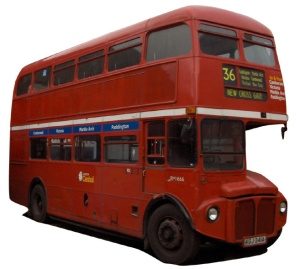 Unless you have invented a completely new product or service, it is very likely that there are large competitors already in your marketplace, established competitors that you will be trying to outwit and outmaneuver. Even if you do have a completely new product or service, customers still have alternatives. For example, the Segway entered the marketplace with a “revolutionary product with no competition”, but the truth is that it entered a marketplace with a smorgasbord of alternative competition (walking, bicycling, roller-skating, skateboarding, etc.). This alternative or substitute competition has proven far stronger than any direct competitor ever could. So what can a small firm do to outmaneuver the big guys or outwit the sneaky substitute competition that is easy to overlook in the passion of the startup process?
Unless you have invented a completely new product or service, it is very likely that there are large competitors already in your marketplace, established competitors that you will be trying to outwit and outmaneuver. Even if you do have a completely new product or service, customers still have alternatives. For example, the Segway entered the marketplace with a “revolutionary product with no competition”, but the truth is that it entered a marketplace with a smorgasbord of alternative competition (walking, bicycling, roller-skating, skateboarding, etc.). This alternative or substitute competition has proven far stronger than any direct competitor ever could. So what can a small firm do to outmaneuver the big guys or outwit the sneaky substitute competition that is easy to overlook in the passion of the startup process?
The key to any startup outwitting or outmaneuvering the established players begins with strategic innovation. To create a strategic innovation you must first truly understand competition in your industry. Competition amongst firms in any marketplace is typically defined by a few key product or service features (value dimensions). In microprocessors the defining competitive feature in the minds of 90′s consumers was megahertz, while in assembled computers the keys were megahertz and megabytes. These two industries had yet to be fully commoditized so the arms race was along these dimensions of value. In a fully commoditized industry however, firms end up competing mostly on the value dimension of price. Why is this true?
The answer is that in a fully commoditized industry, consumers find the alternatives to be “good enough” on the value dimensions that matter to them and so the consumer generally selects the alternative with the lowest price. This behavior drives price competition and lower margins, and makes commodity industries generally not a nice place to be. So how do you avoid product commoditization or how do you create a strategic innovation in a commoditized industry?
Strategic innovations allow your organization to avoid or rise above commoditization. In addition to an in-depth understanding of your industry’s competitive environment, strategic innovation requires an intimate understanding of the customers. From this intimate understanding you are hoping to identify a value dimension that is incredibly important to the customer but woefully under served. This value dimension could be price, as Southwest Airlines proved in the airline industry, but most likely will be something else. Starbucks‘ strategic innovation was developed along the value dimensions of:
- A consistent and repeatable exceptional coffee experience
- A network of convenient locations
Strategic innovation requires that your product or service is “good enough” across the value dimensions that currently matter to customers, and creates “customer delight” on a value dimension that you identify through your extensive customer research as being incredibly important but woefully underserved (see Figure 1). Once you identify such a value dimension the difficult work truly begins. Now you must ask yourself how easy would it be for my competition (direct or substitute) to begin competing on this value dimension instead?
If it would be relatively easy for your competition to replicate your insights and the resulting product or service, then you have discovered a sustaining innovation – an innovation that takes the product or service to a higher level of value for the customer, but not capable of transforming your position in the industry. A true strategic innovation is powerful precisely because it will be incredibly difficult for the established competition to replicate. How did Southwest Airlines succeed by competing on price?
Southwest Airlines achieved strategic innovation not because they recognized that price was important to customers, but because they created an organization from the ground up that was capable of delivering low fares with great service. Their ground up organizational focus on people and cost ensured success where previous low fare carriers had failed. Established competitors have been unable to replicate their success. Delta with Song and United with Ted both crashed and burned in dramatic fashion. To get a better idea of what goes into a strategic innovation, look at Figure 2 to see a few of the key components of Southwest’s success:
Let’s shift back to you now. Once you’ve got that great product or service idea and possibly even a value dimension to build your company’s strategic innovation around, how do you get traction on that steep road to success?
Even if you have the greatest widget known to mankind, the likes of which nobody has ever seen before, you can’t just open a storefront and wait for the customers to walk in. You have to go out and effectively market your widget by first selecting who to sell to. Refuse to make this decision and you are doomed. Make the wrong decision and you will burn through valuable cash and potentially burn up any chance of creating success (no matter how good your product or service is). The key to gaining traction is identifying where the greatest customer pain solvable by you is, and for which customers are willing to pay a relative unknown to solve the pain for them (see Figure 3).
Encountering companies or consumers not willing to buy from an unknown is a key hurdle that some entrepreneurs never overcome, sentiment embodied in the popular phrase “Nobody ever got fired for hiring IBM.” This resistance may require you to seed your market by entering less than ideal arrangements with leading influencers in your target market. Being first is daunting for buyers and may require financial encouragement and hand holding, so that you have the opportunity to turn them into passionate advocates for your product or service in the future.
If you have created a truly valuable product or service, and ideally some level of strategic innovation to go with it, now hopefully you will have the time and opportunity to gain a foothold in your market and expand into other niches before the established competitors are able to replicate your success.

 Sign up here to get Human-Centered Change & Innovation Weekly delivered to your inbox every week.
Sign up here to get Human-Centered Change & Innovation Weekly delivered to your inbox every week.
 Please join me March 14-16, 2012 in London, England for a three day innovation masterclass based on my popular book Stoking Your Innovation Bonfire.
Please join me March 14-16, 2012 in London, England for a three day innovation masterclass based on my popular book Stoking Your Innovation Bonfire. Traffic is a problem for drivers and bus riders alike. When traffic gets bad, it gets even worse for buses downtown. Here is why:
Traffic is a problem for drivers and bus riders alike. When traffic gets bad, it gets even worse for buses downtown. Here is why: Seattle and other communities should take a second look at double-decker buses for popular routes that traverse the city center or look to banish “bendy” buses from downtown routes altogether. Double-decker buses are only slightly taller than most standard buses, have a smaller footprint than bendy buses, and give riders a nice view of the city.
Seattle and other communities should take a second look at double-decker buses for popular routes that traverse the city center or look to banish “bendy” buses from downtown routes altogether. Double-decker buses are only slightly taller than most standard buses, have a smaller footprint than bendy buses, and give riders a nice view of the city.
 I was flipping through the throwaway coupon circular the other day to see if there were any coupons for anything that I buy anyways, and I came across a couple of items that for me it wasn’t immediately obvious what they were. At the bottom you have an item that looks like a cross between a milk bottle and a flower, but is in fact a room freshener spray, and at the top you have an item that almost looks like a night light but is a room freshener. Both of these are part of the new
I was flipping through the throwaway coupon circular the other day to see if there were any coupons for anything that I buy anyways, and I came across a couple of items that for me it wasn’t immediately obvious what they were. At the bottom you have an item that looks like a cross between a milk bottle and a flower, but is in fact a room freshener spray, and at the top you have an item that almost looks like a night light but is a room freshener. Both of these are part of the new  Unless you have invented a completely new product or service, it is very likely that there are large competitors already in your marketplace, established competitors that you will be trying to outwit and outmaneuver. Even if you do have a completely new product or service, customers still have alternatives. For example, the Segway entered the marketplace with a “revolutionary product with no competition”, but the truth is that it entered a marketplace with a smorgasbord of alternative competition (walking, bicycling, roller-skating, skateboarding, etc.). This alternative or substitute competition has proven far stronger than any direct competitor ever could. So what can a small firm do to outmaneuver the big guys or outwit the sneaky substitute competition that is easy to overlook in the passion of the startup process?
Unless you have invented a completely new product or service, it is very likely that there are large competitors already in your marketplace, established competitors that you will be trying to outwit and outmaneuver. Even if you do have a completely new product or service, customers still have alternatives. For example, the Segway entered the marketplace with a “revolutionary product with no competition”, but the truth is that it entered a marketplace with a smorgasbord of alternative competition (walking, bicycling, roller-skating, skateboarding, etc.). This alternative or substitute competition has proven far stronger than any direct competitor ever could. So what can a small firm do to outmaneuver the big guys or outwit the sneaky substitute competition that is easy to overlook in the passion of the startup process?